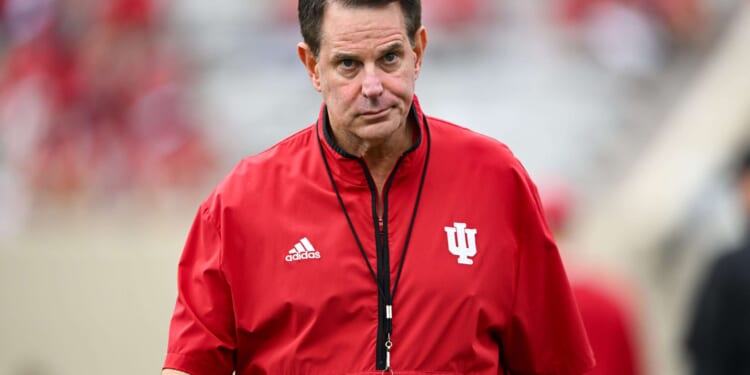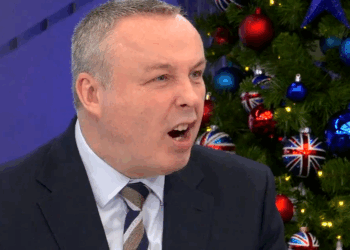Hello and welcome to another edition of Free Agent! It’s important to have multiple talents, so don’t be afraid to take that guitar lesson this week.
Let’s talk about college football coaches today, and why your favorite school shouldn’t overpay them. Then we’ll proceed to Formula 1’s gamble on a broadcast deal with Apple TV, and close with a short review of Chad Powers.
Don’t miss sports coverage from Jason Russell and Reason.
- The U.S. is bidding to host the 2031 Women’s World Cup—with Mexico, Costa Rica, and Jamaica. There are no competing bids, so the U.S.-led bid should get easily confirmed in April 2026.
- U.S. Soccer pitched a dramatic overhaul of college soccer, including unique eligibility rules, separate conferences, and even promotion and relegation.
- A costly $500 million program will monitor 2026 World Cup venues for drone threats.
- FIFA reverses course, says maybe President Donald Trump is allowed to move World Cup matches out of “unsafe” cities after all?
- Should a “city” with 5,000 people have an MLB stadium? North Kansas City might try to lure the Royals over the border. Speaking of villages, a Swedish soccer team from an area of just 1,500 people won the league.
- Illinois Gov. J.B. Pritzker had $1.4 million in gambling winnings last year, reportedly on blackjack in Las Vegas. (The same governor who just increased taxes on sports bettors last month.)
- Reminder: If you don’t want MLB players to go on strike after next season, go ahead and join the Blue Jays’ bandwagon. Neutrals will probably want to avoid the team whose manager wants to “really ruin baseball.” (Although maybe freaking out over three potential titles in six years is a bit overwrought—that’s not even a dynasty.)
- Elsewhere in Reason: “Zohran Mamdani’s Socialist Housing Plan Could Crash New York’s Rickety Rental Market“
- Someone probably should have thought about this earlier.
So the past few weeks you’ve all seen a bunch of “Pass the SCORE Act!” ads from the NCAA and various conferences.
Maybe it’ll eventually get passed. But, bigger problem: I don’t think the bill is even constitutional.
My new article with @SportsLawProf makes that case. https://t.co/PSXkxqgYd4
— Sam C. Ehrlich (@samcehrlich) October 20, 2025
When Penn State football coach James Franklin was fired on October 12, I thought it was the end of the gravy train for college football coaches. But four days later, Indiana gave coach Curt Cignetti an eight-year, $93 million extension—fully guaranteed, even if he gets fired (without cause).
This season, the coaching carousel started early: There have already been nine coaches fired, most of them at pretty big schools. By this time last year, only two coaches had been fired; they weren’t fired until October 20, and they had been coaching at less competitive schools (East Carolina and Southern Miss). I’m usually against knee-jerk firings after a few bad games or one bad season (even if the interim coaches suddenly started winning games), but the schools with coaching vacancies have a huge opportunity: to not overpay a head coach for the first time in college football history.
I’m exaggerating, of course, but the sport has changed and the coaches might just be less important than ever. It used to be that players were paid with exposure by playing for a big school, or by the potential stardom promised by the sure-to-come success of playing for a great coach, or by luxurious facilities. Now players are being paid by something that speaks louder than all of that: money.
Schools don’t need an awesome coach to get good recruits! They can just pay the players more than the other schools.
I often think of this paragraph from Rodger Sherman’s Substack newsletter: “Now, we’re heading into The Paying Players Era. The need for workarounds is coming to a close….[But] schools are still spending huge amounts of money on all the other stuff out of habit. Wake up! You can just pay the players now. No need for Pimp My Ride-ass athletic facilities with a waterfall, two shark tanks, and Playstation 5s in every locker. You can just pay the players and they can buy their own Playstation 5s if they want them.”
Coaches still need to be competent leaders with quality staff. But they used to recruit players year-round, assemble rosters, and meet with boosters. Some of that is still going on, but now big teams are getting general managers to shoulder some of that load.
Technically there’s a salary cap on how much schools can pay their athletes (spread across all sports). But athletes and schools quickly figured out that cap doesn’t apply to indirect payments from boosters through name, image, and likeness collectives. All of this is making the sport more even and competitive anyway. Talent is getting spread out, so the median school in a big conference can still put together a decent season, perhaps with a big upset, even with a below average coach.
This all raises the questions: Why do universities do this? Why do they dedicate so many resources to fundraising for athletics, take on massive sums of debt, and get tied up in the drama of college sports? Are they crazy?
They are not. It’s all down for the sake of recruitment—of regular students, not athletes. Colorado might be 3-4, but all the free media they get for having coach Deion Sanders is part of a 20 percent spike in applicants. When Cal (a.k.a. the University of California, Berkeley) hosted College GameDay last year, its application page got thousands of visits. Butler’s back-to-back Cinderella runs to the Final Four gave it a 163 percent increase in applications.
It makes sense why schools spend millions of dollars on athletics. But they don’t need to do it on coaches.
In an intriguing deal that other sports leagues will be looking at, Formula 1 is moving away from U.S. broadcaster ESPN and will head behind the Apple TV paywall for at least five years. It’s an interesting bet for F1, which must feel like it was plateauing a bit with ESPN after eight seasons. But moving behind a paywall in its emerging U.S. market seems like a questionable deal for F1 in the long run.
In the short run, F1 gets $140 million a year, a lot more than the $85 million ESPN had been giving them. But this isn’t much by F1 standards—Red Bull Racing had $418 million in revenue last year, and they’re just one of the 10 (soon to be 11) teams. ESPN, to be fair, did a great job of carrying the action largely uninterrupted—but that makes it difficult to make money on commercials.
The most likely outcome of the Apple TV deal is that F1’s existing fans get more engaged, but that it’s harder for new people to get into the sport. That’s basically what’s happened with Major League Soccer, which has a similar deal with Apple TV (though most of the soccer games require an extra subscription). An Apple TV subscription costs $13 a month, so an F1 newcomer will have to be really excited to make the jump for $150-plus a year (the F1 calendar runs from early March through early December, so fans who would unsubscribe for the offseason won’t be saving much).
F1 will be hoping Apple can make new fans out of some of the millions of iPhone users in the U.S. (estimates range from 136 million to 151 million iPhones in the country). Apple will apparently promote F1 on Apple Fitness+, Apple News, Apple Music, Apple Sports, and Apple Maps. I’m biased, but I’m skeptical this is going to work because I’m an iPhone user who doesn’t use any of those apps.
Luckily for F1, I’m already a big fan, and I don’t mind the change because I already have Apple TV. It’s unclear whether Apple TV is going to get its own commentators or just broadcast the British Sky Sports feed like ESPN has been doing. I’m quite fond of the Sky team and think they do a great job, so I’d love for Apple TV to stick with that. But if Apple TV does its own thing that I don’t like, at least I’ll also have access to F1 TV Premium at no extra cost.
Either way, the sport will benefit most from exciting action, regardless of who’s broadcasting it. If this season’s three-way race for the title can come down to the final race, it’ll suck new people in for years to come—that’s what worked on me in 2021.
The final lap of Abu Dhabi 2021 was a breathtaking, controversial climax that redefined Formula 1 history. @F1 pic.twitter.com/560tk5xR6H
— Sports Highlights Digest (@SportsDigestHQ) August 7, 2025
It feels a bit under the radar given the stars involved, but Omaha Productions made a fictional Hulu TV show out of Eli Manning’s 2022 skit where he went undercover at Penn State tryouts as “Chad Powers.” Now you can watch the great Glen Powell do the same thing in scripted form.
But if you can’t handle the awkwardness of The Office, this show is not for you. Most of the jokes and hijinks revolve around Powell’s character trying to keep the charade up with high-level makeup and prosthetics. Through four episodes, I’ve laughed a few times but mainly cringed (my mom was visiting and had a few good laughs, though).
I can’t exactly give Chad Powers a high recommendation, especially when October has been such a great month to watch real sports on TV instead. But if you have a Hulu subscription anyway and have a free night, feel free to give the first episode a shot and form your own opinion. (It’s worth noting the show filmed in Georgia and probably got a nice financial boost from the Georgia Film Office, an awful subsidy program that shouldn’t exist.)
Not quite a walk-off, but a late go-ahead home run to win a pennant is tough to beat. (Honorable mentions to the Broncos’ comeback and this wild game-winning catch.)
That’s all for this week. Enjoy watching the real game of the weekend, the bowl-eligible Cincinnati Bearcats against the Baylor Bears.

















